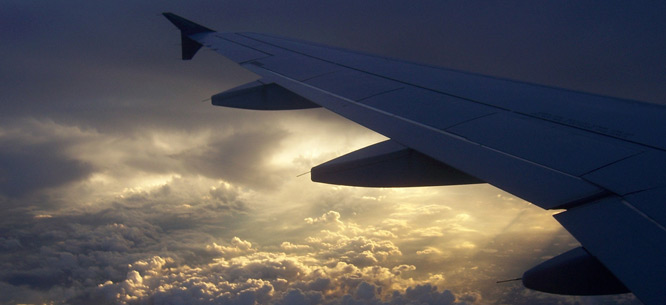Flight Risk
Flight Risk

A Ukrainian academic from Donetsk told me last year that the region of eastern Ukraine where Malaysia Airlines flight MH17 was shot down is sometimes called the “house of burning stones.” The coal-rich region is home to shallow methane repositories that sometimes break through the surface, where exposure to oxygen causes an eruption of flame. Strolling through the rural Ukrainian countryside, one may very well come across these flaming stones. One might imagine that it was over a similar pyre that Hero of Alexandria created the first jet engine 2,000 years ago, when he found that a boiler suspended above a fire rotates as it produces steam.
We now know that at least two fires consumed parts of the Malaysia Airlines wreckage upon impact, burning the bodies of the passengers and the things they carried—teddy bears, birthday cards, laptops. “The weapon used was a 9N314M-model warhead carried on the 9M38-series of missiles, as installed on the Buk surface-to-air missile system,” the Dutch Safety Board’s investigative report states. “How many passengers had already died before the impact on the ground could not be determined.”
There will always be unknowns, things that can’t be said. “Noises similar to violent blows on the cockpit door were recorded on five occasions between 9 h 39 min 30 (point) and 9 h 40 min 28,” French investigators write in their report on the Germanwings flight that a suicidal co-pilot drove into the ground after locking his colleague out of the cockpit. Comparison, simile, and elision can be useful when it comes to making sense of plane crashes. Perhaps that’s why people take comfort in giving and receiving the imperative wish to “have a safe flight.”
The weekend flight MH17 went down, I was called in to do a series of television interviews, to participate in the 24/7 news frenzy that tends to accompany reports of a plane crash. CNN had lined up a roster of aviation experts to comment on the news—some would rotate in and out for the duration of the day. After our segment, one of the experts sidled up to me. He had something he wanted to show me on his phone, a link a friend had sent that might have some evidence, he said. Flags symbolizing the separatist republics in eastern Ukraine flanked Russian text. It was a propaganda website, this expert was surprised to hear. That can be the margin of error with these sorts of things.
How does one parse the special terror that comes with news of any aberration in air travel, the terror that immediately propels articles on the subject to the top of the “most read” column of every news site? September 11 irrevocably changed America’s relationship to flying, and each new crash carries the potential to be “another 9/11” until news anchors report there is no evidence of a terrorist link. But perhaps the fear goes deeper than that, to what the promise of flight first connoted to its inventors.
For Paul Virilio, the theorist of the accident, Hero of Alexandria invented not only the steam engine but also the propulsive disaster. “To get what is heavier than air to take off in the form of an aeroplane or dirigible is to invent the crash, the air disaster,” he writes. The ever-accelerating speed at which life is conducted in this century comes with a human cost—both MH17 and the rocket that felled it are products of this new order.
The first dirigibles were produced when time was slower; flight could be conceived as a form of championing the individual, an emblem of the conquering spirit of republicanism. Felix Nadar, a pioneering nineteenth-century balloonist, was one of the first people to dream up the concept of the airplane—he called it “heavier-than-air” travel—after a nearly fatal accident in a hot air balloon he called the Géant. To promote the idea, he wrote a pamphlet called Le Droit au vol, or “The Right to Flight,” in 1865. “The title . . . neatly implied that flight had somehow become one of the Rights of Man,” Richard Holmes explains in Falling Upwards, a history of pioneering balloonists. Nadar asked Victor Hugo, an aerial enthusiast, to write in support of his extreme idea. (George Sand also praised the effort, but later privately withdrew her support, Holmes explains.) Hugo’s Letter on Flight heralded the advent of mechanical flight as the start of a populist, republican revolution. “It will bring the immediate, absolute, instantaneous, universal and perpetual abolition of all frontiers, everywhere . . . Armies will vanish, and with them the horrors of war, the exploitation of nations, the subjugations of populations. It will bring an immense and totally peaceful revolution. It will bring a sudden golden dawn, a brisk flinging open of the ancient cage door of history, a flooding in of light. It will mean the liberation of all mankind.”
The populist current remained present as the first planes began delivering airmail around the world. “A silent communion, deep within them, united Riviere and his pilots in the battle. All were shipmates, sharing a common will to victory,” Antoine Saint-Exupery writes in Night Flight, his account of the first treacherous night mail flights over the Andes.
Today, air travel has come to mean the annihilation of the individual at the altar of convenience. Commercial flight has become a fundamentally impersonal, submissive, out-of-body experience; its victims become collateral damage of capitalism’s comings and goings.
One of the ways this manifests, outside the dehumanizing security lines and passport checkpoints, is, oddly enough, in the airline safety video. Most airlines choose to stage their videos either using actors performing in front of a green screen or with animated human-like figures buckling their seatbelts in a simulated plane. Rarely if ever do they show live actors demonstrating safety procedures in a real airplane—that would be far too realistic to make for easy viewing. No one likes to visualize the potential conditions of their demise.
Instead, the passenger is coaxed into thinking she is anywhere but an airplane. Air France, for example, has reimagined the airplane as a flying chateau, an appendage of the nation. Its new “safety performance” video, set against a baby blue Louis quatorze backdrop, counsels that a properly fastened seatbelt “will elegantly highlight your waistline,” and that “a no-smoking flight is simply chic.” Models in striped boatneck shirts and A-line skirts twirl through the instructions.
The resulting message is a display of nationalism a world apart from the famous 1870 image of a triumphant Marianne gesturing up to a hot air balloon, the symbol of French resilience during the Siege of Paris. Both images are coercive; the difference is that one is a celebration of French triumph, the other of French stereotype.
Flight has always been a nationalistic endeavor, which is why state-owned airlines compete to expand their aerial empires with the greatest number of destinations served. Flying over the Andes, the hero of Saint-Exupery’s Night Flight feels “like some conqueror who, in the aftermath of victory, bends down upon his territories and now perceives the humble happiness of men.” Aerial catastrophes are usually also national ones.
But that relationship takes a more sinister tone when the efficiency and pace of this expansion becomes more valuable than the people it serves. The victims of the Germanwings and Malaysia Airlines flights have all been assigned monetary valuations—Lufthansa offered the families of the Germanwings victims $28,000 in compensation per victim “for pain and suffering in the minutes before the crash,” according to the New York Times. On May 21, families were insulted by a text message they received from the company informing them that the delivery of their loved one’s remains would be delayed. “Lufthansa defended the decision to communicate via text message, saying it was preferred by some of the families and was the fastest and most efficient way to reach the 1,000 people they needed to inform,” the Times reports. The best way to send news of a delayed flight is also the easiest way to communicate news of a delayed body, it turns out. A whole slew of firms now do good business defending victim’s families against this logistical ferocity, trying to slow down time.
The first explorers of the air often marveled over the lifelessness they encountered above the clouds. “The silence that reigns in these high regions of the air is so oppressive that we cannot help asking ourselves if we are still alive. But death does not reign here; we are impressed only by absence of life,” balloonist Camille Flammarion wrote of one 1867 expedition over France, according to Holmes. Today, the speed at which travel occurs threatens to make flying even more inhospitable, to make it a “vol” in another sense—a robbery of life.
Linda Kinstler is a Marshall Scholar at the University of Cambridge.








